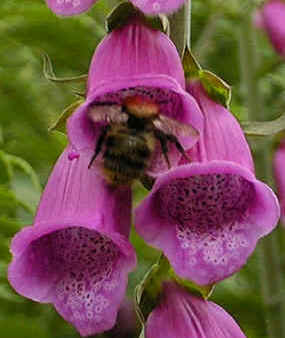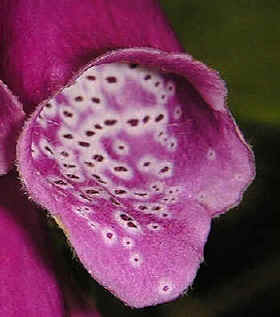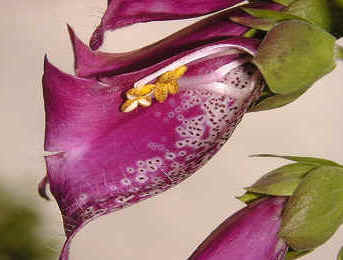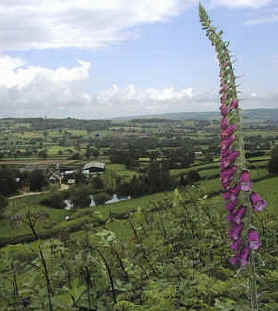- The bees visit the flowers in order to drink the nectar which is situated
at the end of the tunnel shaped flower. In order to mark out the route to
the nectar source the foxglove uses spots. These spots are known as nectar guides.
They may also help the bee to find the landing stage. Note the tunnel
shape of the flower and that the bumble bee has to push its way through this
tunnel in order to get to the nectar which is situated at the base of the flower. The sides
of the flower turn outwards helping to guide the insect into the flower.
|
 |
- Close up of the mouth of the flower. Note the shape, the landing
area, the guard hairs, spots and colouring
as well as the downward attitude of the flower.
|
 |
- A section cut through the flower to show the male and female reproductive parts, the
anthers and stigma. Note how they are flattened into the roof of the flower. It is
therefore impossible for the bumble bee to get to the nectar without brushing against the
reproductive parts. In this way pollen from the male anthers is transfered to the female
stigma. The spots leading to the nectar can also be clearly seen.
|

|
- Once a pollen grain has been transferred to the stigma, a pollen tube will then
germinate from it and grow down through the style. When it reaches an ovule inside the
ovary, fertilisation will then take place. The petals are no longer required and they fall
off exposing the ovary. As the seeds mature the ovary swells. The ovary eventually dries
up and opens allowing the small seeds to be dispersed by the wind. The height of the plant
also aids the spread of seeds. Note the green immature ovaries with the protruding style
which are visible in the lower part of the picture.
- Foxgloves are highly successful at dispersing their seed and rapidly colonise areas
where the land has recently been cleared. For this reason they are known as pioneer
species.
- Foxgloves have medicinal properties in that they contain digitoxin which is used to
stimulate the heart. For this reason it should not be eaten and is considered poisonous.
|
 |
- Finally, the foxglove is the logo of the East Devon Area of Outstanding Natural Beauty (AONB).
This 103 square mile area includes the East Devon Heritage Coast. The 40 mile East Devon
Way runs through the rich and varied countryside of the AONB. It links footpaths,
bridleways and stetches of country lanes to create an inland route from the west of the
District right the way through to the Dorset border in the east. Linking in to the East
Devon Way are four circular or Local Walks, which allow walkers to explore further,
distinctive areas of East Devon. A beautifully illustrated guide is available. Contact the
East Devon District Council.
|
 |



